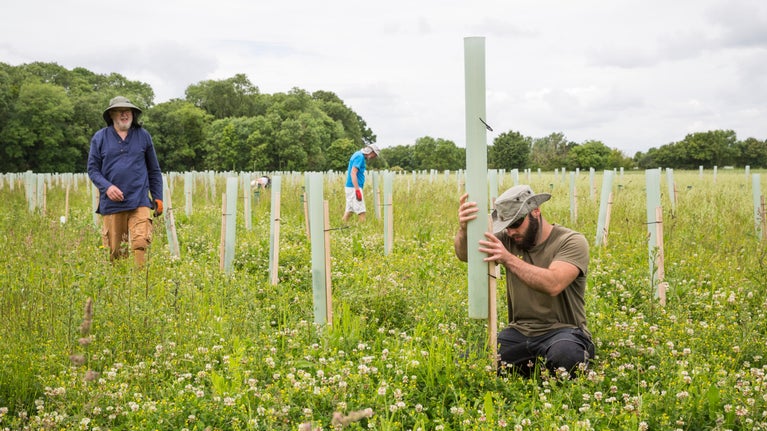
Tackling climate change
Uncover how we’re responding to the changing climate at places in our care.

Medmerry Nature Reserve, in West Sussex, was at extreme risk of flooding from high tides and storms. Learn about how the restoration of intertidal habitat, including saltmarsh, helped flooding and coastal erosion issues.
Medmerry Nature Reserve, in West Sussex, sits on a section of England’s southern coastline which includes the small town of Selsey. This area was at extreme risk of flooding from high tides and storms. However, restoration of 183 hectares of intertidal habitat, including saltmarsh, means that Medmerry now provides not only some of the most important places for birds in Britain but cost-effective flood-risk management for 348 properties, for the local water treatment facility and for the only road to a local town servicing 5,000 residents. The new saltmarsh area also sequesters and stores carbon, helping to mitigate climate change, and helps the area to adapt to sea level rise and coastal erosion caused by climate change.
This was all achieved through a process known as managed realignment. This involves building new sea defences inland from the coast and allowing a new ‘intertidal’ area to form seaward of the intertidal defences. Natural intertidal habitats such as saltmarshes and mudflats would ordinarily absorb strong waves to reduce the depth and length of peak water levels and erosion from storm surges. When this habitat is lost, or when it is not able to move naturally inland as sea levels rise, coastal communities are put at much greater risk of flooding.
There have been significant economic benefits from the managed realignment at Medmerry. Maintenance of the previous coastal defences, a 3km shingle bank, was costing the Environment Agency £300,000 per year. The overall direct economic benefits are estimated at £90 million, compared with project cost of £28 million.
Local people are using this new, easily accessible green space to exercise and socialise and collectively help manage the reserve, which helps improve their health and mental wellbeing. The project has also helped to attract green tourism; based on the use of the car parks alone, it is estimated that there are at least 30,000 visitors a year. Local farmers are also able to get higher prices for the beef produced from the cattle that graze the saltmarsh grasses on site, given that the beef has a higher percentage of salt that is favoured by consumers.
Since the creation of the site, bird populations have flourished. The breeding and wintering populations of wading birds such as avocets, lapwings and oystercatchers have all increased significantly. Notably, avocets first bred at RSPB Medmerry in 2014, and in 2019, 22 pairs nested. Also in 2014, black-winged stilts bred, only the third successful breeding record in the whole of the UK.
This is a case study linked to the Climate and Land Summit hosted by the National Trust at the Wimpole Estate, in Cambridgeshire, on October 12, 2021, before the UN's annual climate conference COP26 in Cornwall in November that year.
Attendees at the summit represented some of England’s largest landowners and managers, and signed up to six guiding principles to commit to collectively working towards the nation’s net zero aims and pressing needs to adapt to a rapidly changing climate. To read the text of the Compact click here.

Uncover how we’re responding to the changing climate at places in our care.

The Royal Society for the Protection of Birds is a charitable organisation registered in England and Wales and in Scotland.
Learn about the six climate and nature-based targets discussed at the Climate and Land Summit and how the solutions are being applied at National Trust places.

From tips on saving water to combatting plastic pollution, learn more about our work to protect precious coasts and rivers for wildlife and people, and what you can do to help.

We’re tackling the threats of a changing coastline to safeguard the places you love. Find out how our teams are adapting their approach to our shifting shores.

With support from the Government’s Green Recovery Challenge Fund, we're looking for ways to protect our environment and combat climate change. Find out more about the work we're doing.

Discover more about the National Trust’s role at COP26 in Glasgow and how you can help tackle the climate crisis.

Discover the vital ways peat supports the environment, from carbon store to archaeological record, and see some of our key projects protecting and restoring the peatland in our care.
